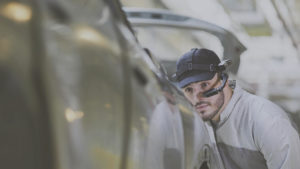The History of Connected Worker Technologies
Connected worker solutions allow businesses to generate actionable data and keep their workers safe in the field.
Connected worker technologies are transforming the way frontline workers perform their jobs. CBT’s Connected Worker solution enables workers in the field to access critical data and resources remotely and more efficiently communicate with their geographically dispersed team members.
But where did these connected worker technologies come from?
Connected worker technologies are part of the evolution of technology trends that have been gaining popularity over the last decade or longer. Even if you aren’t familiar with connected worker, you probably know something about the internet of things (IoT) and wearables. Both these technologies are predecessors and building blocks for connected worker solutions.
While both IoT and wearables have their roots in consumer technology, they have been adopted by business organizations as a means of tracking assets and generating actionable data. As a hybrid of these technologies, connected worker has emerged with use cases in a myriad of industries and companies.
Let’s take a closer look at the origins and history of connected worker technologies:
Internet of Things (IoT)

When IoT came along, it was part of the home of the future. Using IoT meant automating the climate control in your house; waking up to a full, piping hot pot of coffee; and automating your lawn sprinklers.
Flash forward and IoT has been embraced by industry. Manufacturers, utilities, and oil and gas companies use IoT to track assets and conduct preventative maintenance. Industrial assets are equipped with sensors and beacons that generate valuable data about their status. With IoT, inventory can be tracked, asset health can be monitored, and the supply chain can be managed.
Enabled through IoT, connected worker technologies are about connected devices communicating with each other to deliver data and resources to remote employees. Whether through smartphones, tablets, or wearable devices, connected worker is about delivering real-time information to workers in the field so they can make faster, better-informed decisions. Video conferencing enables employees to share what they’re working on from their project site and receive real-time advice from subject matter experts.
Utilizing connected devices also enables remote employees the ability to view live data such as asset sensor readings or pull up static documentation such as manuals, maintenance records, P&IDs, step-by-step instructional videos, and more. Using custom combinations of connected worker technologies, or solutions, CBT empowers our customers’ employees in the field to make real-time, data-driven decisions that benefit their business.
Wearables

Wearables also originated as a consumer technology. Smart watches and smart glasses were designed to operate like portable smartphones, giving access to the internet and responding to voice commands.
Wrist bands, such as Fitbit, were meant to collect biometric data, such as heart rate, blood pressure, physical exertion, or even blood sugar levels. Healthcare has adopted wearables as a means of tracking patients with chronic conditions and alerting the patient and caregiver of troubling trends.
GoPro is a wearable camera that allows adventurers to take spectacular first-person viewpoint video while skiing, scuba diving, mountain climbing, or parasailing. In likeness, connected worker solutions can employ wearable compute devices (equipped with cameras) to further augment the capabilities of field-level employees and ensure they perform their jobs effectively and safely.
CBT’s Connected Worker solutions leverage wearables in the industrial space by using a wearable compute headset that can be mounted on work-appropriate headgear, such as a construction or utility worker’s helmet, a ballcap, or even on a simple head strap. This head-mounted tablet enables all the capabilities discussed in the previous IoT section and more. Perhaps the most notable benefit of opting for a connected worker solution enabled on a wearable device (as opposed to a smartphone or a handheld tablet) is that it’s completely handsfree – all the power and capabilities of a regular compute device available through simple voice commands.
These headsets are worn by an employee so that their viewpoint can be shared (via video) and the wearer can receive critical information from their operations team or control room. The device connects through to the network or to a cellular signal so two-way audio and visual communication can take place between the field rep and virtually anyone else in the world.
Since the device is controlled via voice command and viewed via an unobtrusive heads-up display, users have both hands free to continue working on complex manual tasks such as asset maintenance and repair. The remote employee can also retrieve (handsfree) live data such as asset sensor readings or pull up static documentation such as manuals, maintenance records, P&IDs, step-by-step instructional videos, and more. Using CBT’s Connected Worker solution enabled on wearables, employees in the field can make faster, better-informed decisions while optimizing safety, utilizing fewer physical resources, and driving operational costs down.
Industry 4.0
LNS Research sees connected worker solutions as part of the trend toward Industry 4.0 or the Factory of the Future. Industry 4.0 describes the use of smart technologies in industrial settings.
According to LNS, 46% of industrial companies are using connected or wearable technologies and more than half have implemented or plan to use some type of augmented reality technology. Drivers for adoption include operational excellence, product quality, and improved worker safety.
Connected worker is still in the early stages. If the trajectory of IoT and wearables is any indication, connected worker solutions are here to stay. As companies discover new use cases for connected worker technologies and see the benefits they bring to early adopters, they will become a mainstay.
The Future of Connected Worker Technology
Look no further than your own business for the future of connected worker solutions. While connected worker has dozens of proven use cases, the sky’s the limit.
CBT’s customizable Connected Worker solutions are developed by integrating the industry’s leading hardware and software into cohesive, easy-to-use platforms. Our partners include Hewlett Packard Enterprise, RealWear, Aruba, PTC, National Instruments and more. With this powerful ecosystem of partners, CBT delivers unique solutions to meet the key business goals of customers in a variety of industries.
With CBT’s Connected Worker, you can empower remote workers with the data, resources, and communications tools they need to optimize their safety and efficiency. Bottom line: CBT’s Connected Worker improves productivity and profit margins for our customers.
See Connected Worker in action and imagine the possibilities for your business. Schedule a demo with CBT.
